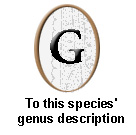

|
|
.615 mm | ||||
| 3.5 | 17. | 24. | 63. | 92.5 | |
| 2.5 | 5.5 | 6. | 6.5 | 3.5 | |
The single wing occupies an area one-tenth the body width at the middle.
The cephalic probolae are the striking feature of this species, being very
slender and approaching the labial probolae in length. The first
half of their length is fringed by triangular membranes while the terminal
half is setose. A peculiar feature is the bifuraction of one of the
termini of the cephalic probolae. The bifurcate labial probolae end
is triangular, forward pointing branches and are fringed with triangular
membranes. The posterior portion of the pharynx is heavily cutinized
but apparently the plates are undeveloped. In most respects the body
closely resembles that of complexus.
Tail conoid, apiculate with the phasmids near the middle.
Male unknown.
From decaying sugar beet roots, Murray, Utah.
(Description- Thorne, 1925)
 |
 |